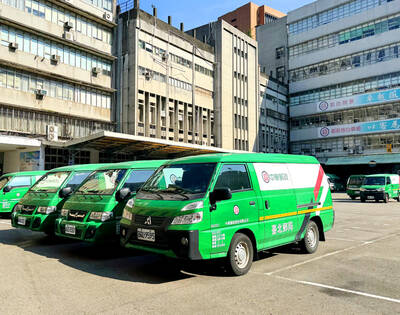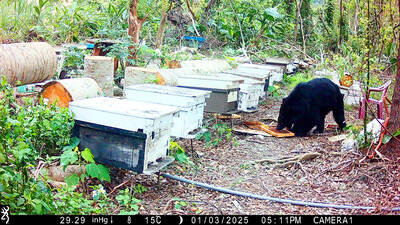Technology-related research and development (R&D) spending last year made up 3.63 percent of the nation’s GDP, with most of it coming from private businesses, the Ministry of Science and Technology said yesterday.
The ratio of R&D spending to GDP has been setting new records over the past few years, rising from 3.09 percent in 2016 to 3.63 percent last year, the ministry said.
Last year, the nation’s overall tech-related R&D expenditure was NT$718.8 billion (US$25.96 billion), up by 8.8 percent over 2019, ministry data showed.
Among the total, 83.2 percent, or NT$598.2 billion, came from non-government sectors — such as higher-education institutions, non-profits and private enterprises — while 16.8 percent, or NT$120.6 billion, came from the government, up by 10.6 percent and 0.7 percent respectively, the data showed.
In 2016, non-government sectors contributed 78.6 percent to the nation’s total R&D spending on technology, while the government contributed 21.4 percent, the data showed.
Thanks to the nation’s success in curbing the COVID-19 pandemic, its economic activities last year were not halted, the ministry said.
Rising demand for products related to 5G, artificial intelligence of things and remote operations have spurred the nation’s R&D in semiconductors, it said.
About 71.3 percent of last year’s spending, or NT$512.2 billion, was devoted to technical development, followed by 21.7 percent (NT$156.1 billion) to applied research and 7 percent (NT$50.5 billion) to general research, data showed.
“The business sector remains the main pillar of the nation’s research and development efforts. Its contribution to the nation’s total R&D spending has been exceeding 80 percent since 2018,” the ministry said.
The overall R&D workforce is also growing, with researchers making up 58.5 percent of the workers, followed by technical and support staff at 36.5 percent and 5 percent respectively, ministry data showed.
However, the R&D workforce is aging, with the number of personnel aged 45 or older rising over the past few years, the data showed.
The nation’s R&D funding and personnel are growing despite barriers presented by COVID-19, but there are still many challenges ahead in the post-pandemic era, the ministry said.
In related news, a bill on the ministry’s reorganization on Tuesday passed a third reading in the Legislative Yuan, meaning the ministry is to be restructured into a national science and technology council.
A bill for the establishment of a new digital development ministry also passed its third reading.
The ministry was known as the National Science Council before March 2014.
The ministry on Tuesday said that a council would be better equipped to facilitate interagency negotiation, and connect advanced research and industrial applications.
The new council is to be inaugurated in March, it said.
The council, to be comprised of tech leaders and representatives from various agencies, would be more beneficial for the nation’s development, former minister of science and technology Chen Liang-gee (陳良基) wrote on Facebook on Wednesday.

SHIPS, TRAINS AND AUTOMOBILES: The ministry has announced changes to varied transportation industries taking effect soon, with a number of effects for passengers Beginning next month, the post office is canceling signature upon delivery and written inquiry services for international registered small packets in accordance with the new policy of the Universal Postal Union, the Ministry of Transportation and Communications said yesterday. The new policy does not apply to packets that are to be delivered to China, the ministry said. Senders of international registered small packets would receive a NT$10 rebate on postage if the packets are sent from Jan. 1 to March 31, it added. The ministry said that three other policies are also scheduled to take effect next month. International cruise ship operators

NUMBERS IMBALANCE: More than 4 million Taiwanese have visited China this year, while only about half a million Chinese have visited here Beijing has yet to respond to Taiwan’s requests for negotiation over matters related to the recovery of cross-strait tourism, the Tourism Administration said yesterday. Taiwan’s tourism authority issued the statement after Chinese-language daily the China Times reported yesterday that the government’s policy of banning group tours to China does not stop Taiwanese from visiting the country. As of October, more than 4.2 million had traveled to China this year, exceeding last year. Beijing estimated the number of Taiwanese tourists in China could reach 4.5 million this year. By contrast, only 500,000 Chinese tourists are expected in Taiwan, the report said. The report

The Forestry and Nature Conservation Agency yesterday launched a gift box to market honey “certified by a Formosan black bear” in appreciation of a beekeeper’s amicable interaction with a honey-thieving bear. Beekeeper Chih Ming-chen (池明鎮) in January inspected his bee farm in Hualien County’s Jhuosi Township (卓溪) and found that more than 20 beehives had been destroyed and many hives were eaten, with bear droppings and paw prints near the destroyed hives, the agency said. Chih returned to the farm to move the remaining beehives away that evening when he encountered a Formosan black bear only 20m away, the agency said. The bear

Chinese embassy staffers attempted to interrupt an award ceremony of an international tea competition in France when the organizer introduced Taiwan and displayed the Republic of China flag, a Taiwanese tea farmer said in an interview published today. Hsieh Chung-lin (謝忠霖), chief executive of Juxin Tea Factory from Taichung's Lishan (梨山) area, on Dec. 2 attended the Teas of the World International Contest held at the Peruvian embassy in Paris. Hsieh was awarded a special prize for his Huagang Snow Source Tea by the nonprofit Agency for the Valorization of Agricultural Products (AVPA). During the ceremony, two Chinese embassy staffers in attendance